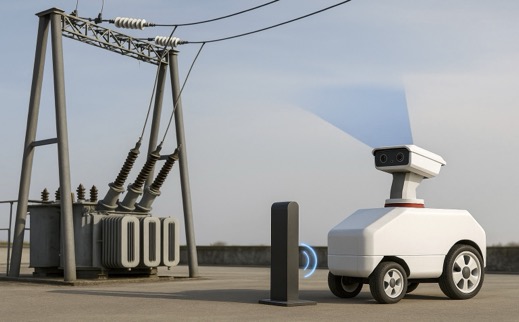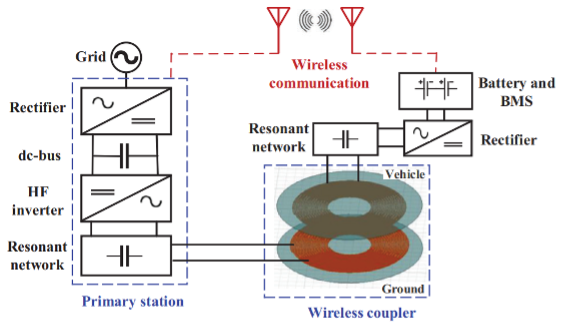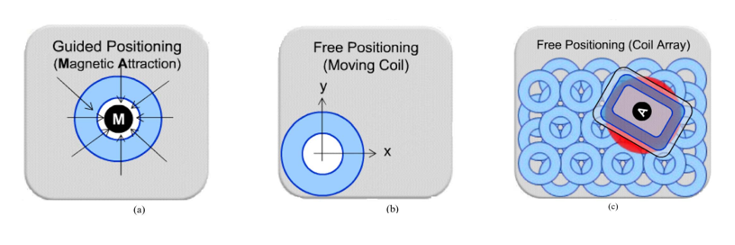Wireless charging, also known as inductive charging, uses electromagnetic fields to transfer energy from a charging pad to a receiver, replacing the conventional plug-in charger. It offers simplicity and convenience for the users and eliminates exposed connectors and the changing cable, even though its charging efficiency is lower than the plug-in charger. Wireless charging technology is widely used in consumer electronics, electric vehicles, medical devices, drones and robots. For example, a factory inspection robot can charge itself without human intervention, shown in Figure 1.

Figure 1: Wireless charging factory inspection robot.
The principle behind this technology is electromagnetic induction. The basic structure is summarized by [1] and shown in Figure 2. An inductive charging system consists of the transmitter, which is usually mounted, and the receiver, which is installed on the charging object. High frequency power, generated by rectified DC voltage and inverter, is sent to the transmitter pad. LC circuit is used to link the power transmission between the transmitter and the receiver. The LC circuit is designed to a resonant frequency, offering the advantages of higher energy efficiency, better coupling over longer distances and easier foreign object detection. A high frequent EMF is generated in the transmitter coil and corresponding voltage is induced in the receiver coil. This voltage is then passed through a rectifier, becoming a DC voltage to charge the battery.

Figure 2: Components of a typical inductive power transfer system [1].
For the process in Figure 2 to work efficiently, the two coils must be closely aligned, typically within a few millimeters to a couple of centimeters apart. Most wireless chargers operate at frequencies between 100-300 kHz, optimizing energy transfer while minimizing heat loss. Based on the configurations of the charging pad and the direction of the magnetic field, the inductive wireless charging can be categorized as vertical flux approach and horizontal flux approach. The vertical flux is more commonly used for consumer electronics since the devices are usually slim. As shown in Figure 3, common topologies include magnetic guided alignment, moving coil alignment and coil array alignment.

Figure 3: Three topologies of vertical flux approach [2].
While the Qi standard dominates consumer electronics, several alternative wireless charging technologies cater to specialized needs. The AirFuel Alliance combines magnetic induction (PMA) and resonance (Rezence), supporting multi-device charging up to 50W for laptops and IoT. For electric vehicles, SAE J2954 standardizes high-power (3.7–11 kW) wireless charging, adopted by automakers like BMW. IKEA’s Ki Cordless Kitchen delivers up to 60W for furniture-integrated appliances, while NFC Wireless Charging (WLC) leverages 13.56 MHz NFC antennas for low-power (1W) small devices. Experimental technologies like Disney’s Quasistatic Cavity Resonance (QSCR) aim for room-scale power, and Open Dots offers an open-source alternative for DIY projects. Despite these innovations, Qi remains the universal choice for smartphones and accessories due to its broad industry support, safety features, and scalability from 5W to future kilowatt-level applications.
Current research in wireless charging is pushing the boundaries of efficiency, range, and scalability. Innovations include long-distance charging via radio frequency (RF) and infrared (IR) beams, enabling device charging across rooms, as well as dynamic wireless charging for electric vehicles (EVs), where embedded road coils power cars while driving. Researchers are also exploring ultra-high-frequency (MHz-range) resonant coupling to reduce coil sizes and improve alignment flexibility. Future applications could revolutionize smart homes with wall-mounted or furniture-integrated charging surfaces, eliminating power cords entirely. In healthcare, implantable medical devices may leverage biocompatible wireless power to avoid battery replacement surgeries. Meanwhile, industrial and IoT sectors are adopting wireless-powered sensors for maintenance-free operation in hard-to-reach areas. With advances in materials science and AI-driven power management, wireless charging may soon deliver seamless, ubiquitous energy access—from consumer gadgets to grid-scale infrastructure.
Learn more about wireless charging, contact Quadrant.
Reference
[1] A. A. S. Mohamed, A. A. Shaier, H. Metwally, and S. I. Selem, "Wireless charging technologies for electric vehicles: Inductive, capacitive, and magnetic gear," IET Power Electronics, 2023
[2] S. Y. Hui, "Planar Wireless Charging Technology for Portable Electronic Products and Qi," in Proceedings of the IEEE, vol. 101, no. 6, pp. 1290-1301, June 2013, doi: 10.1109/JPROC.2013.2246531.
